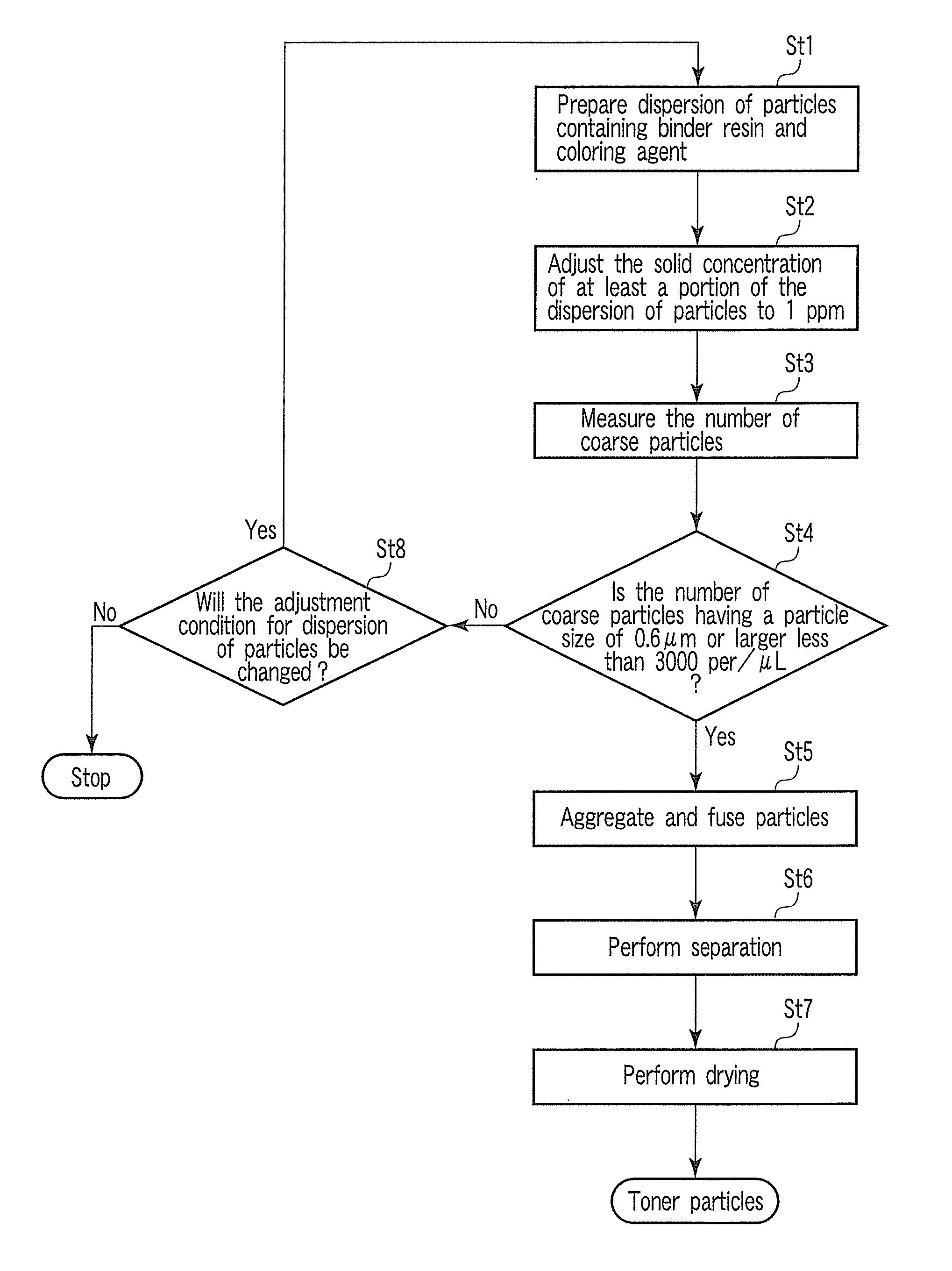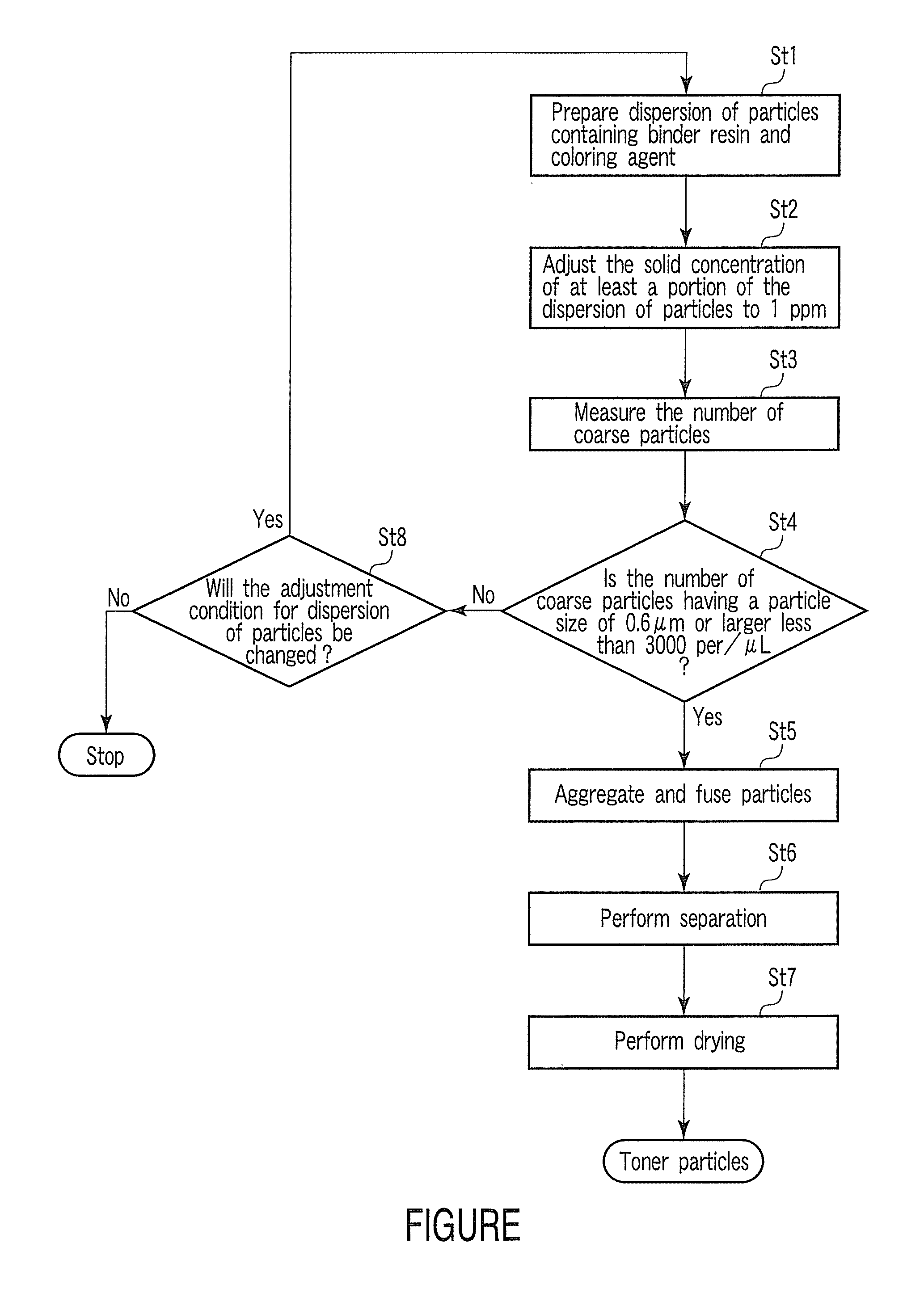Method for producing developing agent
a technology of developing agent and developing agent, applied in the direction of developers, instruments, optics, etc., can solve the problems of releasing coloring agent, difficult to measure coarse particles, and inability to quantitatively measure the number of coarse particles, etc., to achieve good colorability and transparency.
- Summary
- Abstract
- Description
- Claims
- Application Information
AI Technical Summary
Benefits of technology
Problems solved by technology
Method used
Image
Examples
example 1
[0046]95 parts by weight of a polyester resin as a binder resin and 5 parts by weight of a copper phthalocyanine pigment as a coloring agent were mixed and then melted and kneaded by a twin-screw kneader set up at a temperature of 120° C., thereby obtaining a kneaded material.
[0047]The resulting kneaded material was coarsely pulverized into a volume average particle size of 1.2 mm by a hammer mill manufactured by Nara Machinery Co., Ltd., thereby obtaining coarse particles.
[0048]40 parts by weight of the resulting coarse particles, 5 parts by weight of sodium dodecylbenzenesulfonate as an anionic surfactant, and 55 parts by weight of ion exchanged water were placed in CLEAR MIX, and the resulting dispersion was heated to 120° C. Then, the dispersion was mechanically stirred for 30 minutes by setting the rotation speed of the CLEAR MIX to 6,500 rpm, followed by cooling to room temperature, thereby preparing a particle dispersion.
[0049]The resulting particle dispersion was diluted suc...
example 2
[0057]By using a mixture containing 95 parts by weight of a polyester resin as a binder resin and 5 parts by weight of a copper phthalocyanine pigment as a coloring agent, and uniformly dispersing the mixture with a Henschel mixer manufactured by Mitsui Mining Co., Ltd., thereby obtaining coarse particles having a volume average particle size of 0.8 mm.
[0058]40 parts by weight of the resulting coarse particles, 5 parts by weight of sodium dodecylbenzenesulfonate as an anionic surfactant, and 55 parts by weight of ion exchanged water were placed in CLEAR MIX, and the resulting dispersion was heated to 120° C. Then, the dispersion was mechanically stirred for 30 minutes by setting the rotation speed of the CLEAR MIX to 6,500 rpm, followed by cooling to room temperature, thereby preparing a particle dispersion.
[0059]The resulting particle dispersion was diluted such that the solid concentration thereof became 1 ppm. Then, the number of coarse particles having a particle size of 0.6 μm ...
example 3
[0066]95 parts by weight of a polyester resin as a binder resin and 5 parts by weight of a naphthol azo pigment as a coloring agent were mixed and kneaded. Then, the resulting kneaded material was coarsely pulverized into a volume average particle size of 1.2 mm, thereby obtaining coarse particles.
[0067]40 parts by weight of the resulting coarse particles, 5 parts by weight of sodium dodecylbenzenesulfonate as an anionic surfactant, and 55 parts by weight of ion exchanged water were placed in CLEAR MIX, and the resulting dispersion was heated to 130° C. Then, the dispersion was mechanically stirred for 30 minutes by setting the rotation speed of the CLEAR MIX to 10,000 rpm, followed by cooling to room temperature, thereby preparing a particle dispersion.
[0068]The resulting particle dispersion was diluted such that the solid concentration thereof became 1 ppm. Then, the number of coarse particles having a particle size of 0.6 μm or larger was measured by Multisizer 3 manufactured by ...
PUM
| Property | Measurement | Unit |
|---|---|---|
| particle size | aaaaa | aaaaa |
| aperture diameter | aaaaa | aaaaa |
| volume average particle size | aaaaa | aaaaa |
Abstract
Description
Claims
Application Information
 Login to View More
Login to View More - R&D
- Intellectual Property
- Life Sciences
- Materials
- Tech Scout
- Unparalleled Data Quality
- Higher Quality Content
- 60% Fewer Hallucinations
Browse by: Latest US Patents, China's latest patents, Technical Efficacy Thesaurus, Application Domain, Technology Topic, Popular Technical Reports.
© 2025 PatSnap. All rights reserved.Legal|Privacy policy|Modern Slavery Act Transparency Statement|Sitemap|About US| Contact US: help@patsnap.com


